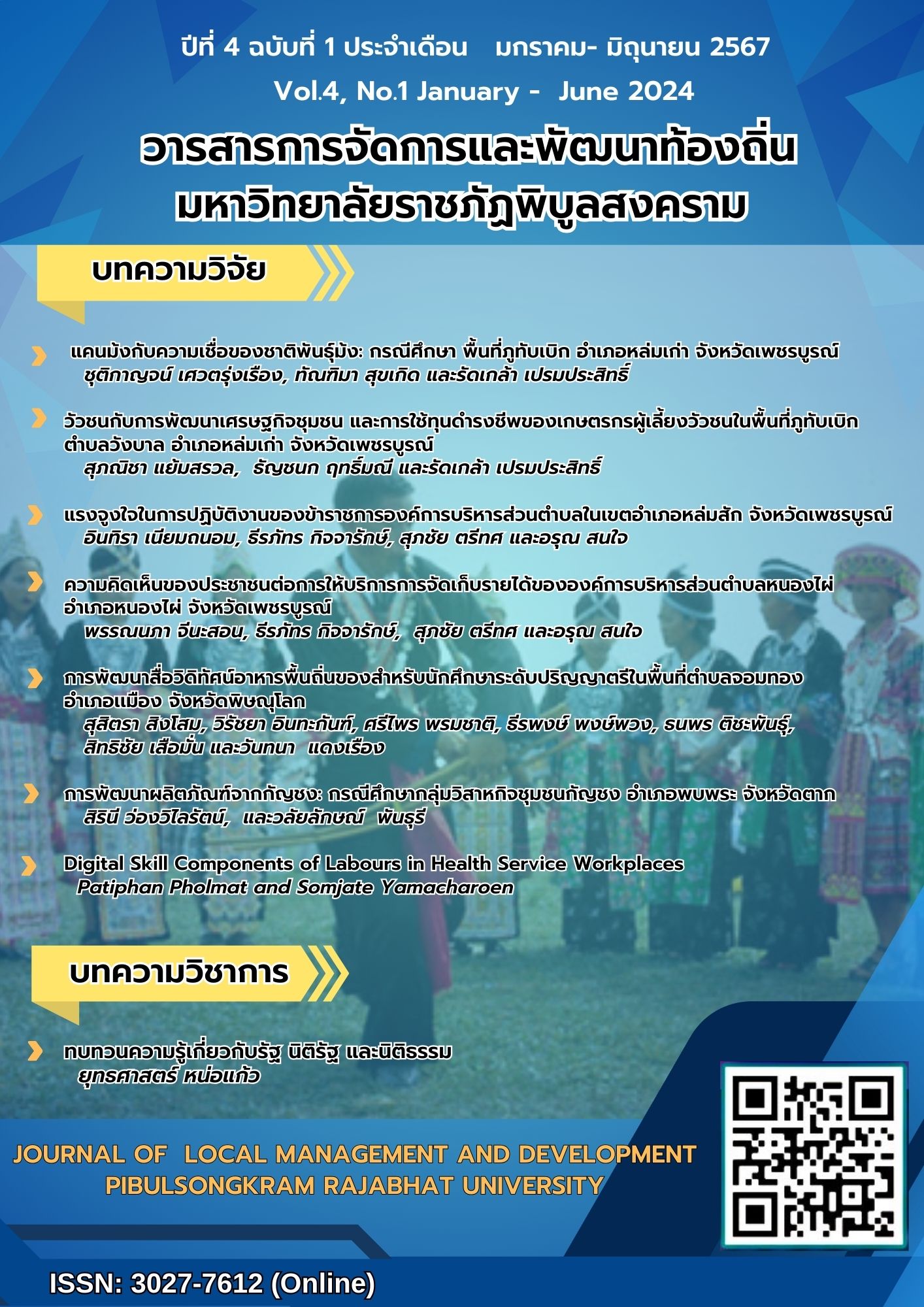Fighting Bulls and Community Economic Development in Phu Thap Buek Area, Wang Bal Sub-district, Lom Kao District, Phetchabun Province
Keywords:
Fighting Bulls, Community Economic Development, living capitalAbstract
The objective of this study was to analyze how fighting bulls supported the community economic development and how those fighting bull farmers in Phu Thap Buek area utilized their livelihood resources/assets. The qualitative research approach was applied by employing the semi-structured interview to collect data from the community leaders and the farmers. The result revealed that raising the fighting bulls essentially helped creating jobs and revenue, it thus played a significant role in community economic development. Even though the sport of bull fighting was brought from the South of Thailand, here in Phu Thap Buek it functioned as an income distribution engine to the community people. It helped creating business related to the sport of bull fighting and other services that later became a supply chain such as providing stable for rent for those bringing fighting bulls to prep before fighting, cultivating grass for selling to those fighting bull owners, operating the shops nearby the bullring to service those visitors to the community prior and on the day of bull fighting, organizing a community market fair to sell products related to fighting bulls etc. Furthermore, it was also found that the livelihood resources/assets of fighting bull farmers should be properly provided as follows, 1) For physical resources, the land must be spacious enough for the fighting bulls to walk around for exercise, and it must has ample water for them, 2) For financial resources, the investment capital must be sufficient to meet with various expenses such as labor cost, food cost etc. 3) For social resources, this is about the network that has been formed among the groups or clubs of those fighting bull famers. They keep corresponding with each other especially during the fighting competitions or festivals. 4) For human resources, the farmers themselves must be equipped with knowledge and skill for this type of livestock, and 5) For natural resources, the location for raising the fighting bulls must be fertile to guarantee the sufficiency of grass supply for them and to help lower the feed cost for the farmers.
References
จรัญ จันทลักขณา และผกาพรรณ สกุลมั่น. (2543). วัวชนกับคนใต้. กรุงเทพมหานคร: สถาบันสุวรรณวาจกกสิกร มหาวิทยาลัยเกษตรศาสตร์.
ชมนาด ศีติสาร. (2554). ความสัมพันธ์ระหว่างคนกับวัว บนเกาะโทะกุโนะฌิมะ. jsn Journal, 1(1), 21 – 41.
สืบค้นเมื่อ 10 มกราคม 2566 เข้าถึงได้จาก https://www.shorturl.asia/pK3z7
ดาวสวัสดิ์ สุขมี. (2545). ศึกษาความเชื่อที่เกี่ยวข้องกับกีฬาชนวัวของชาวบ้านจังหวัดสงขลา. (วิทยานิพนธ์ปริญญาบัณฑิต). มหาวิทยาลัยทักษิณ.
ไพศาล ริ้วธงชัย และคณะ. (2548). การศึกษาแนวทางการเลี้ยงวัวด้วยภูมิปัญญาชาวบ้านเพื่อสร้างเศรษฐกิจชุมชนบ้านนาเปอะ ตำบลชาติตระการ อำเภอชาติตระการ จังหวัดพิษณุโลก. กรุงเทพมหานคร: มหาวิทยาลัยราชภัฏพิบูลสงคราม.
มูนีเร๊าะ เจะแต. (2557). การปรับตัวในการดำรงชีพอย่างยั่งยืนของชุมชนในพื้นที่อุทยานแห่งชาติบูโด-สุไหงปาดี: กรณีศึกษาชุมชนในตำบลปาลุกาสาเมาะ อำเภอบาเจาะ จังหวัดนราธิวาส (ปริญญานิพนธ์รัฐประศาสนศาสตรมหาบัณฑิต). มหาวิทยาลัยสงขลานครินทร์, คณะวิทยาการจัดการ, ภาควิชารัฐประศาสนศาสตร์.
รัดเกล้า เปรมประสิทธิ์. (2563). รายงานการวิจัยฉบับสมบูรณ์การศึกษาคุณภาพชีวิตของชุมชนที่ได้รับผลกระทบจากการท่องเที่ยวในพื้นที่ภูทับเบิก จังหวัดเพชรบูรณ์. พิษณุโลก: มหาวิทยาลัยนเรศวร
รัดเกล้า เปรมประสิทธิ์. (2566). การใช้ทุนการดำรงชีพเพื่อการพัฒนาการท่องเที่ยว: กรณีศึกษาพื้นที่ภูทับเบิก อำเภอหล่มเก่า จังหวัดเพชรบูรณ์. วารสารปาริชาต, 36(4), 142 – 160. สืบค้นเมื่อ 17 พฤศจิกายน 2566 เข้าถึงได้จาก https://www.shorturl.asia/DNyXU
วรวุฒิ โรมรัตนพนธ์. (2549). ทุนทางสังคมกับการจัดการสิ่งแวดล้อม. กรงเทพฯ : มิสเตอร์ก๊อปปี้ (ประเทศไทย).
วศิน ปัญญาวุธตระกูล วารัชต์ มัธยมบรุษ และณัฐชัย อ่ำทอง. (2561). พัฒนาการและแนวทางการจัดการการท่องเที่ยวชุมชนบนพื้นที่สูงภูลมโลและพื้นที่เชื่อมโยง. พิษณุโลก: รัตนสุวรรณการพิมพ์
วิจิตร พุ่มพวง. (2537). วัฒนธรรมกีฬาวัวชนจังหวัดสงขลา. (วิทยานิพนธ์ปริญญาบัณฑิต). กรุงเทพฯ: มหาวิทยาลัยศรีนครินทรวิโรฒ.
วิเชียร ณ นคร. (2545). มรดกวัฒนธรรมทักษิณ. นครศรีธรรมราช: สถาบันราชภัฏ นครศรีธรรมราช.
วิศัลย์ โฆษิตานนท์. (2560). ชนเผ่าม้ง บ้านเข็กน้อย. สืบค้นเมื่อ 8 มกราคม 2566, เข้าถึงได้จาก https://www.shorturl.asia/FlbK1
อาคม เดชทองคํา. (2543). หัวเชือกวัวชน. กรุงเทพมหานคร: สำนักงานกองทุนสนับสนุนการวิจัย.

Downloads
Published
Issue
Section
License
Copyright (c) 2024 Journal of Local Management and Development Pibulsongkram Rajabhat University

This work is licensed under a Creative Commons Attribution-NonCommercial-NoDerivatives 4.0 International License.
ประกาศเกี่ยวกับลิขสิทธิ์
- เนื้อหาและข้อมูลในบทความที่ลงพิมพ์กับวิทยาลัยการจัดการและพัฒนาท้องถิ่นถือเป็นข้อคิดเห็น และความรับผิดชอบของผู้เขียนบทความโดยตรงซึ่งกองบรรณาธิการวารสารไม่จำเป็นต้องเห็นด้วย หรือร่วมรับผิดชอบใด ๆ
- บทความ ข้อมูล เนื้อหา รูปภาพ ฯลฯ ที่ได้รับการตีพิมพ์ในวิทยาลัยการจัดการและพัฒนาท้องถิ่นถือเป็นลิขสิทธิ์ของวารสารวารสารวิทยาลัยการจัดการและพัฒนาท้องถิ่น หากบุคคลหรือหน่วยงานใดต้องการนำทั้งหมดหรือส่วนหนึ่ง ส่วนใดไปเผยแพร่ต่อหรือเพื่อการกระทำการใด ๆ จะต้องได้รับอนุญาตเป็นลายลักษณ์อักษรจากวิทยาลัยการจัดการและพัฒนาท้องถิ่นก่อนเท่านั้น





